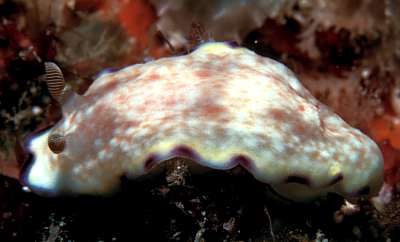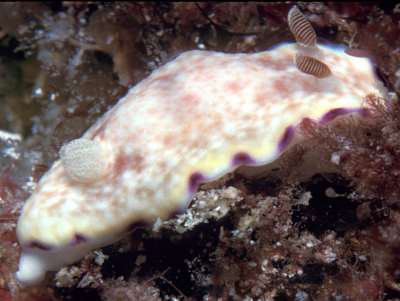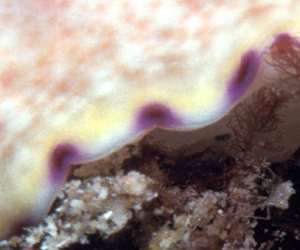Chromodoris alius? from Kwajalein, Marshall Islands
March 7, 2005
From: Scott Johnson


Hi Bill,
Marina Poddubetskaia's recent message [#12900] recording Chromodoris alius from Sri Lanka caused me to dig out my photos of C. rufomaculata from the Marshalls. The attached photos of what I've been lumping with C. rufomaculata appear to match Chromodoris alius. If they do, it would be a fairly long extension of the species' range eastward. The three photos here were all taken at Kwajalein Atoll, Marshall Islands. I have some others from Enewetak Atoll, Marshall Islands, that I will send in a separate message.
I think one feature that threw me off before is that the shape of the gills on these Marshall Islands animals match those of both C. rufomaculata and C. albopustulosa (separate messages) in that they form rather small spherical balls when extended; the specimen from Tanzania on your fact sheet shows the gills much more spread out.
All of these species live in the Marshalls on shallow subtidal lagoon reefs, at depths of about 2 to 10 meters, usually hiding away underneath chunks of sponge encrusted dead coral.
Locality: Kwajalein Atoll, Marshall Islands, Pacific. Depth: 8 m. Length: 20 mm. Under dead coral on subtidal reef. Photographer: Scott Johnson
Scott
uwkwaj@yahoo.com
Johnson, Scott, 2005 (Mar 7) Chromodoris alius? from Kwajalein, Marshall Islands. [Message in] Sea Slug Forum. Australian Museum, Sydney. Available from http://www.seaslugforum.net/find/13185
Dear Scott,
Thanks for these photos. As I have said in response to one of your other messages, I think your photos show pretty good evidence to suggest that C. alius, C. rufomaculata, C. albopustulosa and even C. aureopurpurea are all the same species. You mention the way the gills sit in a spherical ball, which I have called a goblet-shape. In the photo of the Tanzanian specimen you mention, it is possible that the animal was oxygen stressed - I can't remember know, but it was photographed in a dish back in my room back at the university so could have been in a dish of unoxygenated sea water for some time. Certainly specimens of Dendrodoris nigra greatly expand their goblet-shaped gill cluster when kept in stagnant sea water. One very convincing point can be seen in the close-up alongside. In C. aureopurpurea, one characteristic feature of the colour pattern are the dark purple spots aroubnd the mantle edge, each surrounded by a paler purple 'halo' and a yellow crescent-shaped cap on the inside edge. In the close-up alongside we only need the yellow band to be broken between each purple yellow spot for this pattern to be just as in C. aureopurpurea.
I have discussed the identify of these species more fully in a separate message [#13260].
Best wishes,
Bill Rudman
Related messages
-
Chromodoris albopustulosa from Maui
From: Philip A. Thomas, October 5, 2007 -
Chromodoris albopustulosa from Kure Atoll
From: Scott Johnson, March 7, 2005 -
Chromodoris alius? from Enewetak, Marshall Islands
From: Scott Johnson, March 7, 2005 -
Chromodoris albopustulosa from Hawaii
From: Scott Johnson, March 7, 2005 -
More Chromodoris albopustulosa from Hawaii
From: Scott Johnson, March 7, 2005 -
Chromodoris albopustulosa from the Marshall Islands
From: Scott Johnson, March 7, 2005 -
Original illustration of Goniobranchus albomaculatus Pease 1866
From: Bill Rudman, March 7, 2005 -
Original illustrations of some Hawaiian chromodorids
From: Bill Rudman, March 7, 2005 -
White and yellow-spotted Hawaiian chromodorids
From: Bill Rudman, March 7, 2005 -
Original illustration of Doris albopustulosa Pease 1860
From: Bill Rudman, March 7, 2005
